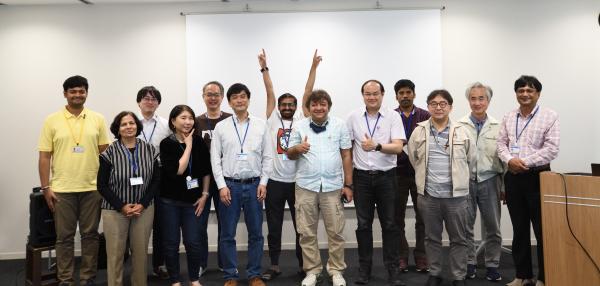2024年6月6日、NIMSにて、Indian Institute of Technology HyderabadのProf. Saswata Bhattacharyyaによるご講演が153回構材ゼミとして開催されました。
Prof. Saswata Bhattacharyya (Indian Institute of Technology Hyderabad)
BIO|Prof. Saswata Bhattacharyya
日時:2024年6月6日(木曜日)13:30-14:30
会場:先進構造材料研究棟 5階カンファレンスルーム
開催者:佐原亮二(計算構造材料グループ)
大出真知子(組織熱力学グループ)
 講演後の集合写真
講演後の集合写真
Prof. Saswata Bhattacharyya(左から8人目)
Abstract:
Splitting Instability in Superalloys: Insights from A Phase Field Study
Saswata Bhattacharyya
IIT Hyderabad, Telangana, INDIA
In precipitation-strengthened alloys, such as Ni-base and Co-base superalloys, cuboidal γ' precipitates often develop solid-state dendritic morphologies during growth when the alloys are aged below their respective γ'-solvus temperatures. This phenomenon stems from a diffusive instability, also known as the point effect of diffusion, where morphological perturbations become unstable due to localized effects of diffusion. These dendritic perturbations often grow along preferred directions due to underlying anisotropy in interfacial and elastic energies. Additionally, the microstructures of these alloys can display “split” morphologies, where dendritic precipitates fragment after reaching a critical size, forming regular octet or quartet patterns of almost equally sized precipitates divided by thin matrix channels. Moreover, experiments suggest that the dendritic morphology of precipitates can be precursors to the splitting instability. Although the phenomenon of splitting has been intensely studied, with various theories proposed for their
emergence, a model that seamlessly connects the growth morphology of solid-state dendrites and the consequent development of “split” morphology remains to be developed.
In our attempt to develop such a model, we employed a phase-field methodology that integrates anisotropy in elastic and interfacial energies to study the growth and coarsening of dendritic γ' precipitates. We conducted phase-field simulations with systematic variation of the intrinsic properties that influence the elastic energy, the interfacial energy, and the alloy composition. Our key discovery is that a decrease in elastic energy density (due to a reduction in elastic interaction energy) promotes the formation of split morphologies, despite an associated increase in surface energy density. Additionally, factors such as supersaturation, elastic misfit, the degree of elastic anisotropy, and interfacial energy significantly influence the development of these microstructures. Our analysis of simulation results, considering classical theories of elastic stress effects on coarsening, demonstrates that negative elastic interaction energy is crucial for stabilizing the split precipitate morphology.